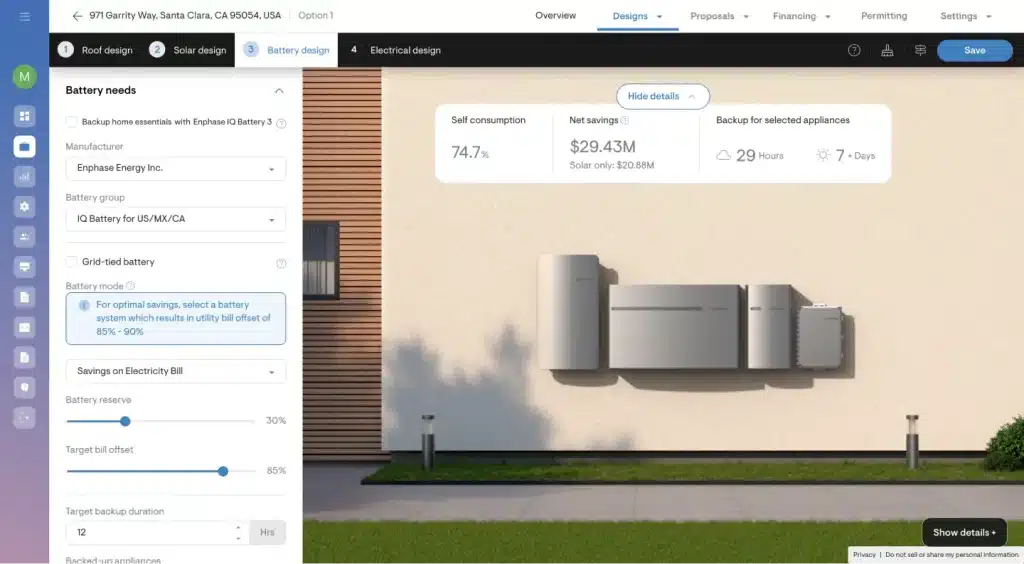Integrating storage solutions with solar systems is a pivotal strategy for the evolving energy ecosystem, transcending environmental concerns to address practical and immediate needs. The economic case for adding storage to solar systems is becoming increasingly compelling with advances in battery technology and declining costs. Incentives like the Investment Tax Credit (ITC), Self-Generation Incentive Program (SGIP), and Grid Services encourage solar-plus-storage systems. Regulatory frameworks such as net energy metering (NEM) policies also incentivize the adoption of these systems, allowing homeowners and businesses to benefit from potential savings and revenue streams.
- Savings optimization
At its core, solar energy presents a remarkable opportunity for homeowners and businesses to reduce their utility bills by generating their power. Adding storage solutions has the potential to unlock significant savings. Storage-equipped solar systems maximize savings by storing excess solar energy during peak production periods and utilizing it during high electricity demand or elevated utility rates. - Enhanced backup power
In a world where power outages can disrupt daily life and pose risks to essential services, backup power assumes critical importance. Storage-enabled solar systems offer a reliable and resilient solution, providing uninterrupted power during grid outages while contributing to community resilience and disaster preparedness in an era marked by increasingly frequent and severe weather events. - Mitigating peak demand charges
For commercial and industrial entities, managing peak demand charges imposed by utilities can significantly impact operational costs. Storage-integrated solar systems proactively mitigate these charges by strategically deploying stored energy during peak demand periods. - Grid independence
In addition to financial benefits, storage-equipped solar systems promote grid independence, empowering consumers to take control of their energy. By generating, storing, and consuming their power, homeowners and businesses reduce their reliance on centralized grid infrastructure, minimizing exposure to grid outages, rate fluctuations, and supply disruptions while promoting energy independence and sustainability. - Futureproofing against utility changes
As utilities evolve and adapt to changing energy landscapes, the regulatory and economic environment surrounding solar energy and storage may change. By investing in storage alongside solar installations, consumers futureproof themselves against potential changes in utility policies, tariffs, and incentives, safeguarding against uncertainties and maximizing long-term returns. - Contributing to energy transition goals
As nations worldwide strive to meet ambitious renewable energy targets and reduce carbon emissions, deploying solar-plus-storage systems plays a pivotal role in accelerating the energy transition. By displacing fossil fuel-based electricity generation and reducing greenhouse gas emissions, these integrated solutions contribute to the fight against climate change and promote environmental sustainability on a global scale.
The Solargraf advantage to battery modeling
Net Energy Metering (NEM) policies have evolved significantly, notably with NEM 2.0 and NEM 3.0. These policies dictate compensation for excess energy fed back into the grid by solar system owners. Under NEM 2.0, utilities compensate solar owners at the retail rate for excess energy. However, NEM 3.0 introduces enhancements by allowing solar owners to export energy during high tariff periods, akin to Time of Use (TOU) tariffs, maximizing savings potential with an added battery.
Solargraf has a robust battery recommendation and modeling tool that supports 25+ manufacturers, allowing installers to generate a battery recommendation and pitch batteries based on the site location, grid connection type, and client needs.
- Savings mode
Installers can use Savings mode to model batteries for grid connection types such as NEM 3.0, Net-FiT, and Gross FiT, or for utilities with Time-of-Use rate structures. This mode allows for a recommendation on using rate arbitrage to discharge the battery during peak tariff periods. By doing so, the battery can power loads or export to the grid when export is selected in NEM 3.0, resulting in increased savings. In this mode, installers can set up a target bill offset percentage and reserve some capacity for backup if needed.Installers can optimize their savings by adding grid-tied batteries to their solar system design using Solargraf’s modeling feature. Since these batteries are much simpler to install and do not require Automatic Transfer Switches, they can be cost-effective and provide enhanced self-consumption. These batteries cannot provide backup during grid outages because they are connected to the grid. - Self-Consumption mode
For NEM 2.0 grid connection types, installers can get a recommendation and model batteries in Self-Consumption mode that optimizes battery usage to minimize dependence on the utility grid. Here, installers can set up a self-consumption target and reserve some capacity for backup if needed. - Backup mode
For areas prone to blackouts and natural disasters, having power backup for emergencies is crucial to adding batteries to solar systems. Solargraf allows the modeling of whole and partial home backup systems with the flexibility to select specific appliances for backup. Installers can go into the details and add electrical details of each appliance to generate a battery recommendation that suits their backup needs.

Embracing the integration of solar power and storage is essential for unlocking the full potential of renewable energy, ensuring a brighter, more resilient future in the modern energy landscape. Solargraf stands at the forefront of empowering solar system designers and installers by providing comprehensive solar and battery modeling tools for primary use cases of self-consumption, savings optimization, and backup power. With the ability to generate a battery recommendation and to compare different battery sizes, Solargraf enables professionals to assess the feasibility and impact of integrating the right-sized battery storage within solar setups, ensuring optimal system performance and customer satisfaction. Installers can also model add-on battery systems to existing solar-only sites. In addition, battery incentives like SGIP and Grid Services can also be baked into the proposal, reducing the overall cost of adding a battery and increasing the chances of closing a deal.
Explore the power of solar with our comprehensive solar proposal software today!


 United States
United States Germany/Austria
Germany/Austria Brazil
Brazil Netherlands
Netherlands Japan
Japan